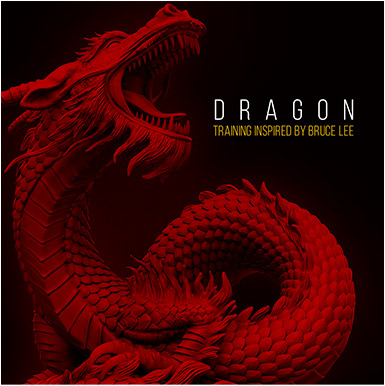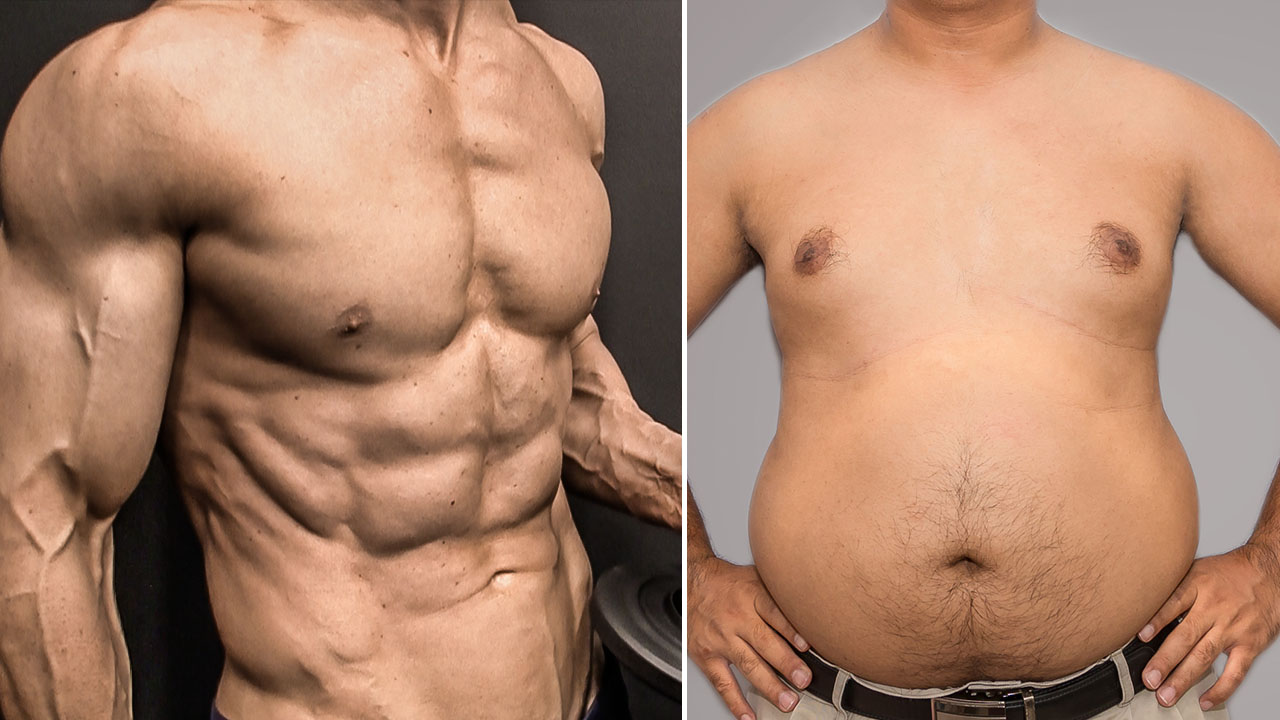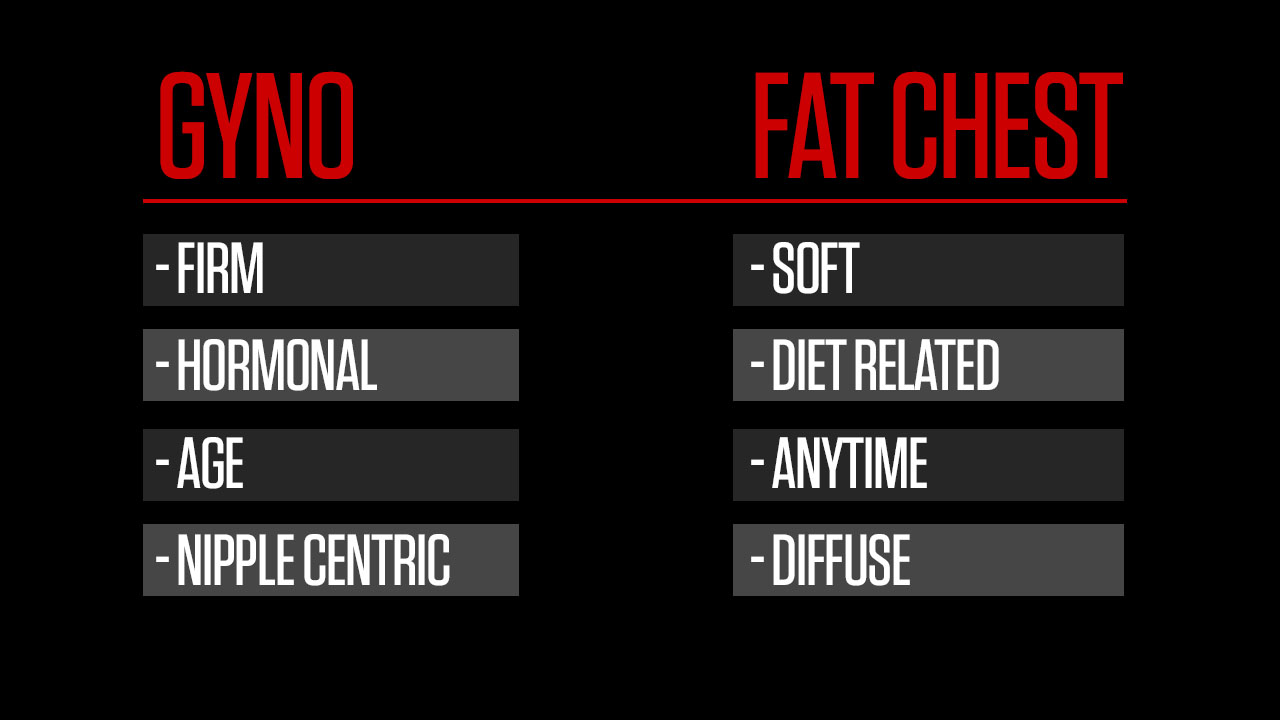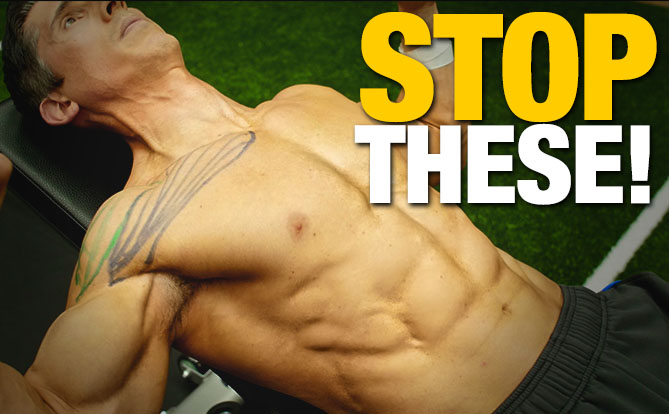
THE PROBLEM WITH THE INCLINE BENCH PRESS
The Incline Bench Press exercise variation is one of the best upper chest exercises there is, but there’s one major problem preventing us from getting the maximum benefit out of it.
The front delt likes to dominate the movement, taking away from the action of the upper chest as the primary muscle!
You see, these two muscles – the anterior deltoids and the upper chest fibers of the pectoralis major – are really close to each other, which means that one of the two can really start dominating the other if we don’t do this dumbbell chest exercise correctly.
The front deltoid gets a great deal of work from not just shoulder workouts and exercises, but as an assistant on many pushing and common chest exercises as well as any every day activities that we do in the front of our body. This causes the front delt to become almost too active, especially during exercises that we are trying to stress the upper chest like the Incline Bench Press.
There are two big mistakes that most people make with the dumbbell Incline Bench Press that are making this situation worse!
If you’re making either of these two errors, it’s preventing you from maximizing your upper body workout.
I’m going to show you the two worst Incline Bench Chest Press mistakes…and I’m going to be breaking out the Muscle Markers to help you get more out of this intense exercise!
First, so we have a better understanding of this popular movement, let’s take a look at what muscles the dumbbell incline bench press works.
INCLINE BENCH PRESS MUSCLES WORKED
- Front Delt
- Clavicular Head (Pectoralis Major)
The main muscles worked during incline presses are the front deltoid and the clavicular head (upper portion of pectoralis major). However, in order to get the muscular activation in the upper pecs in this incline chest press exercise, it’s crucial to get the bench angle correct.
Since we’re trying to use the dumbbell incline bench press to hit the upper portion of the pec major, we want to minimize the activation of the shoulder musculature. Read on to see what the correct incline bench press angle is, and why.
And to ensure you get strong mind muscle connections, take a look at the anatomy below so that you can see where the front delt and the pec major are located.
MISTAKE #1: USING THE WRONG BENCH ANGLE
In order to get the front shoulder to do less of the work and allow the pecs to do more, you have to first get the angle of the dumbbell incline bench press correct when you do this simple movement.
So, what is the angle that you want to use on the incline dumbbell bench press exercise in order to hit the upper chest as the prominent muscle? An Upright Shoulder Press is going to maximize the attention that front delts get because the arms move in a straight line up against gravity in an overhead pressing motion.


If I were to back off the angle of the Upright Shoulder Press and set the incline bench press angle to 60 degrees – which is one of the most common angles that people will do incline presses – then you’re going to position your body to shift the focus down a little bit.
But you can see this is a larger muscle and it’s not enough to put the focus down through the mid-belly of the upper chest.
So setting the flat bench to 60 degrees is a bench angle mistake. It’s not a low enough incline bench setting and you might want to go a bit lower.

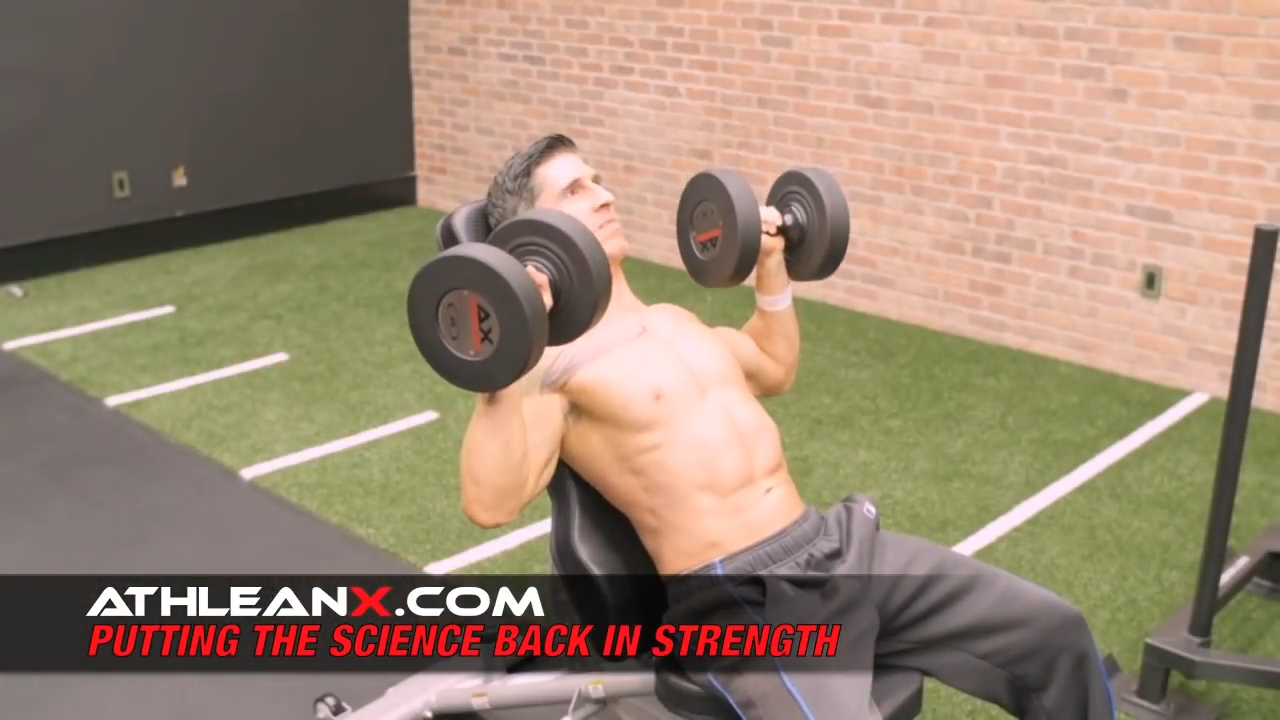
Here we’re setting our adjustable benches down to a 45degree angle, and that’s somewhat better for this dumbbell press.
Anytime you start going lower, you’re shifting that focus down, but at 45 degrees you’re still not really there.


CORRECT INCLINE BENCH PRESS ANGLE
What is the best incline bench press angle for hitting the upper chest?
Research shows that the correct angle of the Incline DB Bench Press should be 30 degrees from flat to target the upper chest for muscle growth.
30 degrees may seem like a very small angle, but it is proper incline bench press form for placing the strain on your upper pecs and minimizing the effect on the anterior deltoid muscles.
Many people will stay much too upright in the starting position when performing this chest exercise, and effectively wind up hitting their shoulder muscles too much.
If you realize that a completely vertical bench position (90 degrees elevated) would primarily achieve shoulder activation, and that a completely flat bench version at 0 degrees (Flat Dumbbell Bench Press, Regular Bench Press or Traditional Bench Press) would hit your middle chest (because your arms are at a 90-degree angle to your body), you understand that you’ll need to lower the bench quite a bit to get upper chest engagement.

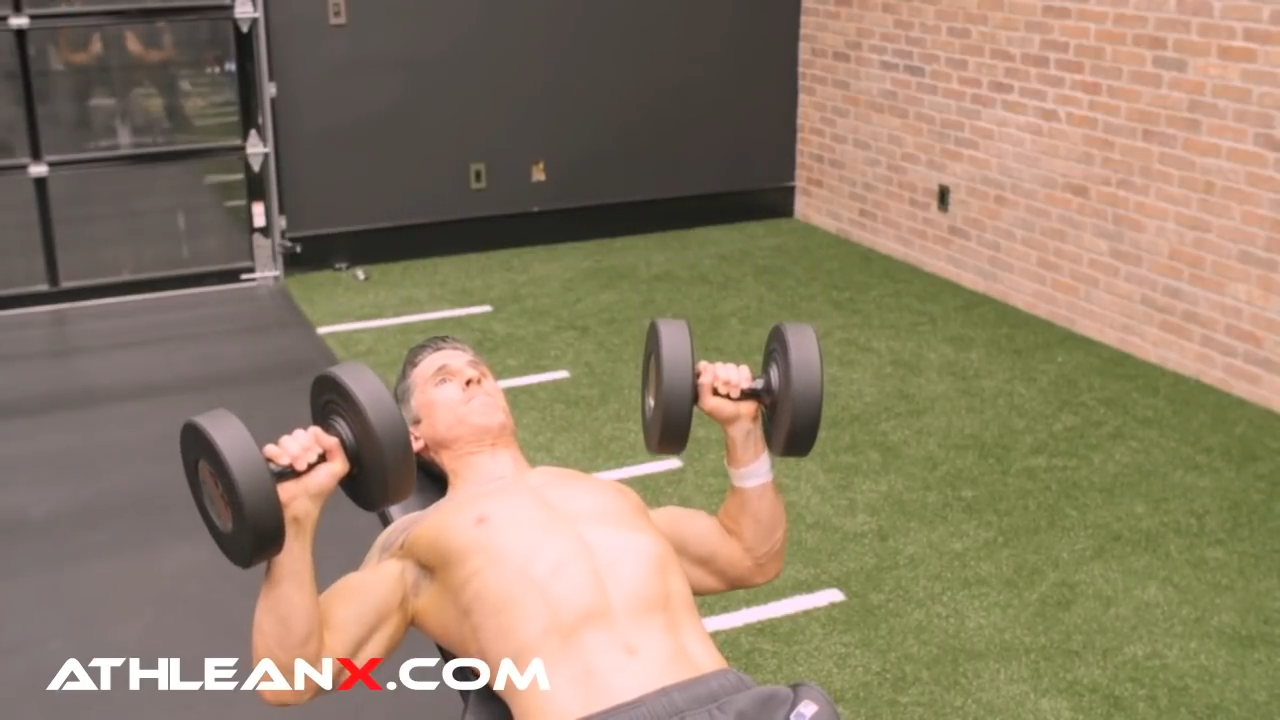
MISTAKE #2: NOT SQUEEZING THE SHOULDER BLADES
As you’ve seen me bang out a couple reps of the dumbbell variation of the Inclined Bench Presses at 30 degrees, notice the position of my shoulder.
When the front delt becomes dominant, our shoulders tend to round forward. A lot of people reading this are probably sitting there right now with shoulders rounded forward.
That’s common, unfortunately.
What happens is, the front delt is actually put in more of a position of power in relation to the chest. It’s actually standing out more, willing and able to push more and spring to action more quickly than your upper chest.
We can silence that by getting it back where it belongs, allowing the chest to now be in a better position to contract. The way to do that is through positioning our shoulders in the right direction.
We want to make sure that whenever we press upward, we contract the shoulder blades back and down.
This back and down position places your shoulder blades backward in a position where they can be less dominant in the Incline Dumbbell Bench Press and put your pecs at the center of the action.

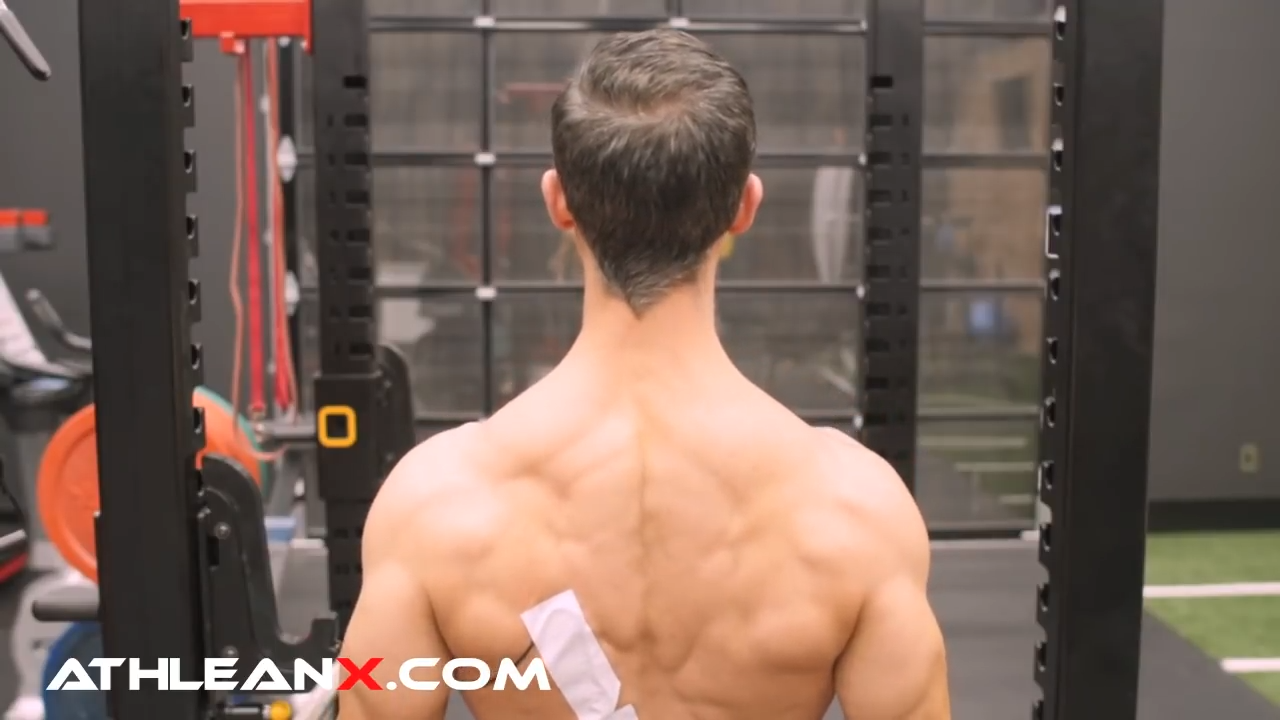
HOW TO DO INCLINE BENCH PRESS CORRECTLY
With the 30 degree angle on the bench, gravity helps to position the shoulder blades back and down, but you can’t just rely on the fact that the bench is helping you get there.
You do need to actively contract your shoulder blades as well to ensure that this happens. Squeezing the shoulder blades makes it much easier for the chest to be in a position of power and therefore increase their contribution to the dumbbell Incline Bench Press. This, over a period of time, will lead to greater chest muscle growth particularly in the upper chest.


HOW TO DO THE INCLINE BENCH PRESS
- Set the angle of the incline workout bench to 30 degrees.
- Grab a pair of dumbbells and position yourself in the bench with feet flat on the ground.
- Actively contract your shoulder blades back and down as you press the weight away from your chest to a full range of motion, using a mind to muscle connection to focus on the upper pecs.
- Lower the dumbbells with control to the starting position and repeat.
I hope you’ve found these exercise guides for the dumbbell Incline Bench Press to be helpful. Remember, this is about putting the science back in strength training. When it comes to strength and muscle building I don’t like to just tell you which are the best exercises to do but instead WHY they’re good and how to get the most out of them so you can get better results faster when you follow our training.
You can see how making even the smallest mistakes in your training can cause lost results and lost time. If you’re looking for a complete training plan that puts the science back in strength and muscle growth, helps you avoid common mistakes and gives you workout tips to get the most out of every single exercise you do, check out our ATHLEAN-X strength programs. See how training like an athlete with the best training tips and exercises can help you lose fat and build strength, power and muscle mass throughout your entire body.

- Because the front delt and the upper chest muscles are so close together, the front delt has a tendency to dominate in the Incline Dumbbell Chest Press. Many people don’t know how to incline bench press with proper form, and there are two common mistakes that make this front deltoid dominance more pronounced and two workout tips I’ve given to correct them.
- Mistake #1: Using the wrong bench angle exacerbates this problem. Research shows that performing an incline chest press with a 30 degree bench angle is the best for the upper chest.
- Mistake #2: Not engaging the shoulder blades in your incline presses also makes shoulders round forward which allows the front delt to be dominant. Making an intentional down and back movement of the shoulder blades helps the upper chest to be in a better position to contract.
INCLINE BENCH PRESS FAQS
Some people find that the incline bench press is harder than flat bench presses because the front delt likes to dominate the movement and tends to take away from the action of the upper chest because of how close in proximity these two muscles are. We're trying to hit the upper chest, not do another compound shoulder exercise, so it's important to get the bench angle right. To make the incline bench press favor the upper chest portion of the pectoralis major more, be sure to use the correct bench angle of 30 degrees and squeeze the shoulder blades. However if you want to build a stronger chest, it's important to use effective exercises to target the middle and lower portions of the pectoral muscle as well. To do this, move from an inclined position to a neutral position on the adjustable bench to hit the middle pecs, and use a declined position to hit the lower pecs.
Research shows that the correct angle of the Incline Barbell Bench Press should be 30 degrees from flat to target achieve the best muscular activation in the upper chest. This is one of the best incline bench exercises for upper chest activation, and one that you should definitely focus in each chest day workout.
Incline bench press training is one of the best upper chest exercises for chest strength and muscle mass, but for this bench press variation you need to ensure that you're not allowing your front delts to dominate the movement. To avoid this, be sure to use the correct bench angle and squeeze your shoulder blades during the movement. The incline bench press will preferably hit the upper chest whereas the flat barbell bench press hits the mid-pecs. Done correctly, incline bench press benefits are that it's excellent for targeting the upper pec muscles and helps prevent muscle imbalances (one-sided muscle weaknesses) when performed with dumbbells, because it is a unilateral exercise.
Some people ask whether a 30 to 45-degree bench position is better for upper pec activation in an incline bench press. Research shows that the correct angle of the Incline Barbell Bench Press should be 30 degrees from flat to target maximum upper chest muscle activation during bench press. Adjustable training benches allow you to change the angle of bench incline so that you can achieve the best possible activation of the upper chest muscle fibers.
To do the incline bench press variation, the bench presser should set the incline bench angle on the bench press station to 30 degrees. Sit on the adjustable weight bench and lean against the backrest, taking a pair of dumbbells in each hand. Press straight outward in front of your chest, squeezing the shoulder blades to avoid the front delts taking over the movement. 30 degrees is the best inclined position to help you to achieve the best upper pectoralis activation. Starting weight for this chest press variation should be with a lighter weight instead of heavy weight for strength gains. As you get stronger in this popular exercise, you can increase your rep range and your sets over time. Once you are doing about 3 sets of 10-12 reps with ease, you can move to heavier weight over time for muscle hypertrophy. Done correctly, dumbbell incline bench presses are one of the best exercises for upper body strength gains and muscle growth, and preventing strength imbalances (differences in strength from one side of the pecs to the other).
The incline bench press is one of the best upper chest exercises, but you need to ensure that you're not allowing your front delts to dominate the movement. To avoid this, be sure to use the correct bench angle and squeeze your shoulder blades during the movement. In order to build strong chest muscles, you should be sure to include exercises that activate upper, mid and lower pecs in your workout routine. To focus on the entire chest musculature, you can use exercises like decline bench presses to hit the lower pecs and a standard bench press to hit the mid pecs by setting the bench to flat bench position.
To achieve the best activation of the upper pectoral muscles and for maximum strength gains and muscle growth, the best incline angle for the barbell incline bench press is 30 degrees from horizontal bench position which you can do on an adjustable type of bench.
Some people want to know if 30 or 45-degree incline bench position is best to hit the upper chest. To achieve the best upper pec activation, 30 degrees is a more optimal angle than a 45-degree angle for the incline bench press. In this incline position, you will be favoring the upper portion of the pec major, making this a very effective exercise for upper chest.
The best incline bench press angle for strength gains and muscle growth in the upper chest is 30 degrees. While some lifters make the mistake of adjusting to a 15 or 45-degree angle, research shows that the influence of bench angle on the upper pecs is greatest at a 30 degree position.
REFERENCES
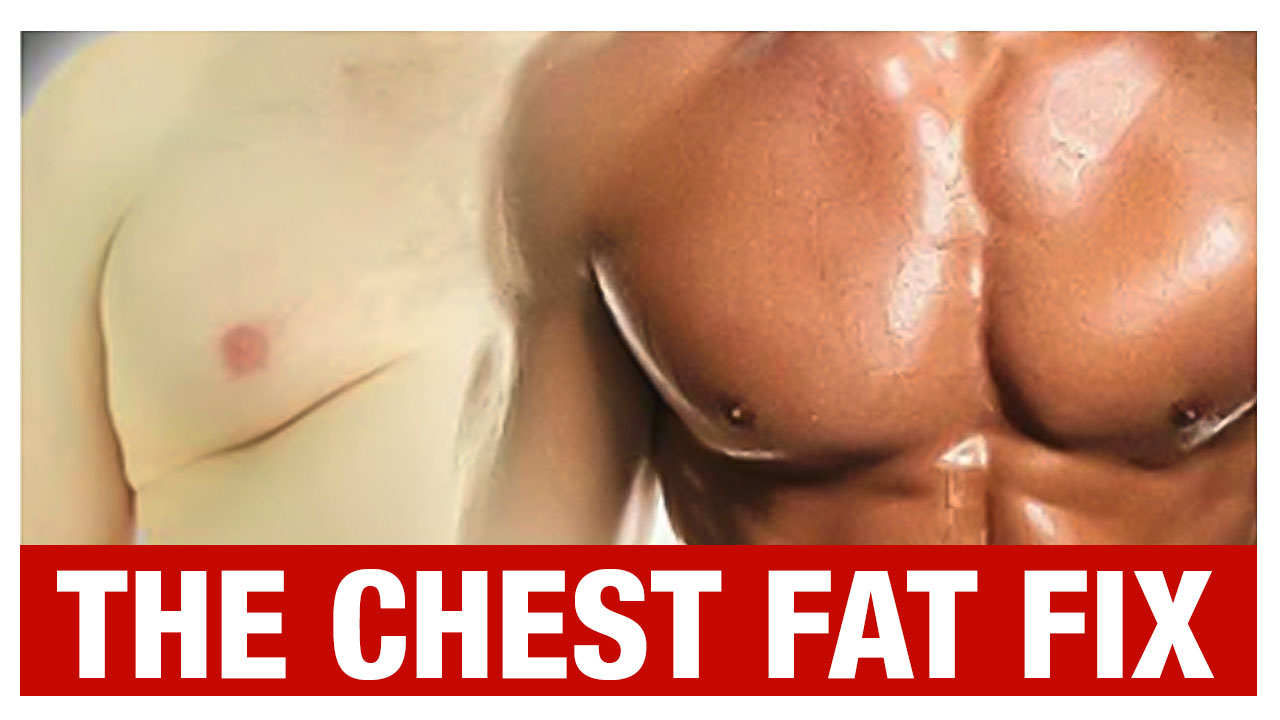
THE TRUTH ABOUT CHEST FAT…
Did you know that second to the abdomen, the chest is where men store most of their body fat?
If you’ve got chest fat, you probably hate it.
When men store excessive body fat in the chest, it can show up as man boobs.
The good news is that there are workout routines, exercises and nutrition tips that can help you learn how to get rid of man boobs and lose the chest fat once and for all!
However, here’s an important fact for you. There are two very different kinds of chest fat, two different causes, and two very different ways to fix it! While most chest fat is caused by overall excess body fat due to nutrition and lifestyle factors, there is another type that is caused by a medical condition.
It’s important to know what causes man boobs so you can find the right solution. We’re going to start out with a discussion of the two main factors that can cause man boobs. And if you’ve got the more common type of chest fat, I’ve got a 3 step plan of attack to help you get rid of man boobs fast!
man boobs: OVERWEIGHT OR HORMONAL PROBLEM?
There are two possible types of chest fat. One type of fatty tissue is related to a hormonal imbalance based medical condition while the other is lifestyle related. Which one do you have?
Let’s take a look at a couple of pictures and scenarios.
The man in the picture below is 34 years old, 5’11” and 210 lbs.
You can see that the excessive body fat is distributed not only in his chest, but that he has belly fat and arm fat as well. He is generally carrying excess weight, most likely weight gain due to a sedentary lifestyle, perhaps alcohol intake, and less than healthy eating habits.
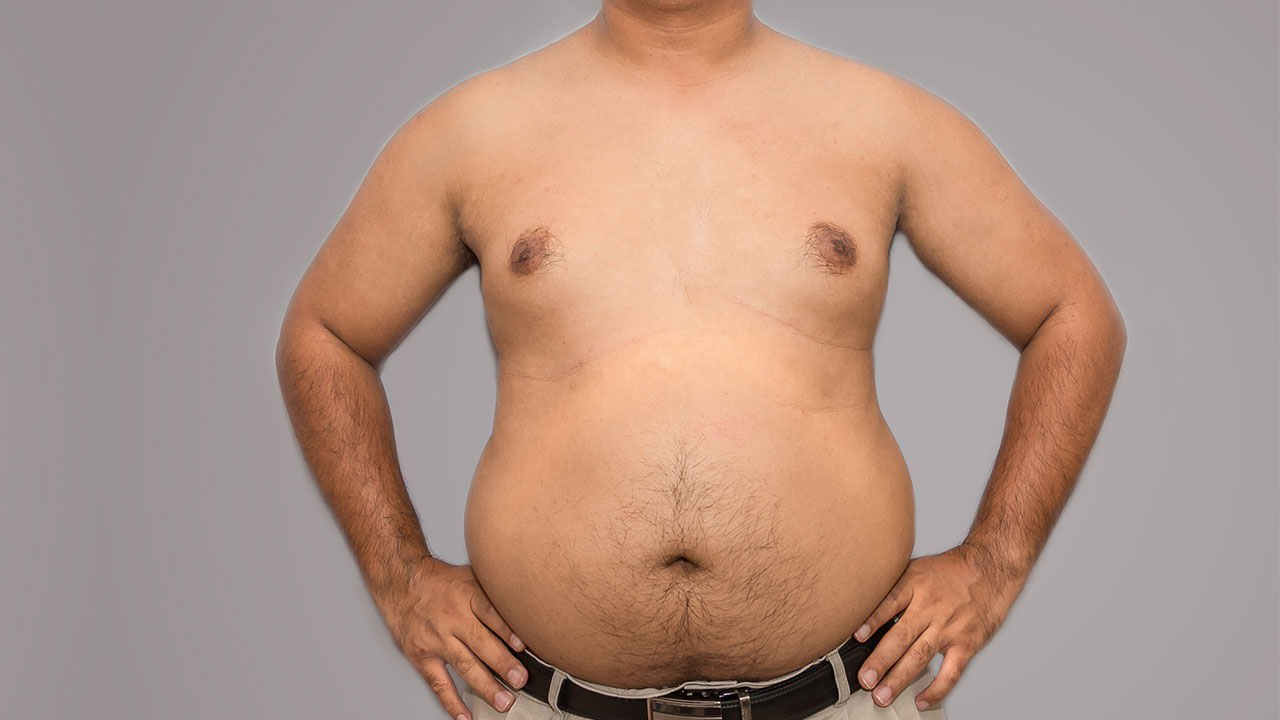
The look of this type of chest fat is usually associated with holding excess body fat.
Now let’s look at the second photograph. You can see that this man has significant fat storage in his chest, but that he has a very different chest appearance compared to the guy above.
This man is 5’10” and 190 lbs.
In other words, he’s of average weight.
So what is causing the accumulation of fat in his chest?
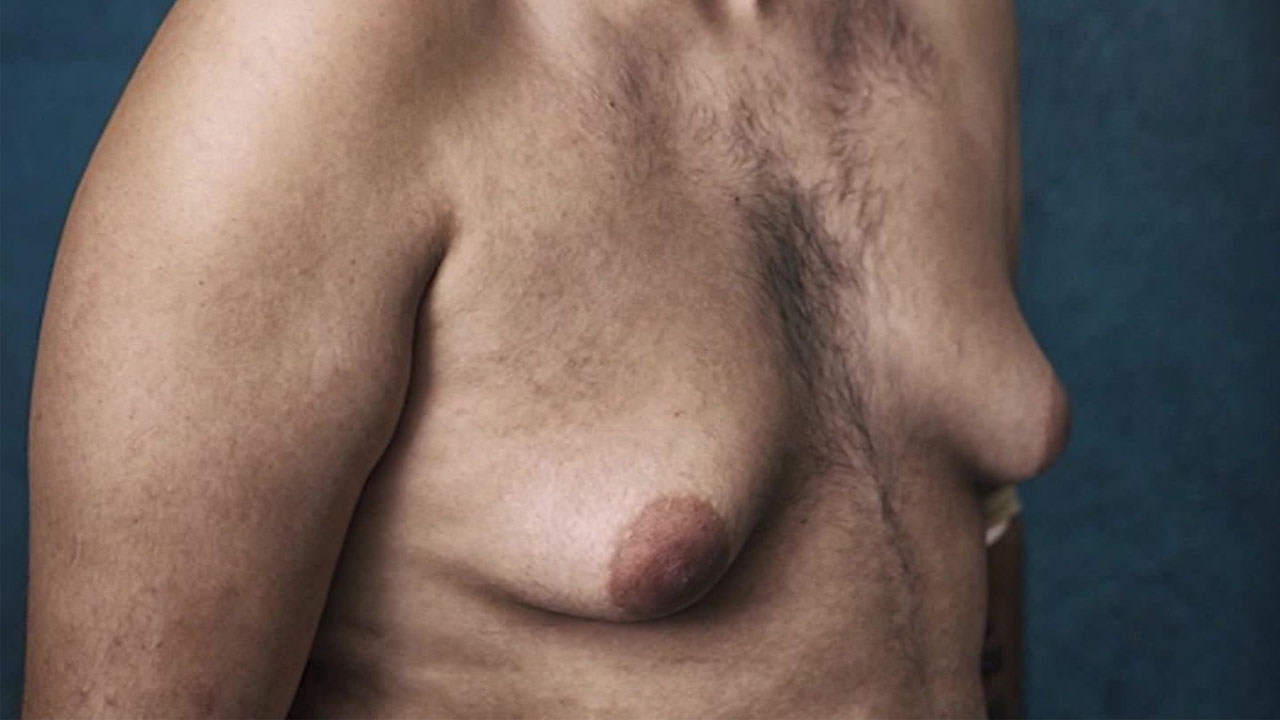
This look of this type of chest fat or ‘man boobs’ is associated with gynecomastia, the medical term for man boobs when there is a hormone imbalance.
This guy has experienced development of gynecomastia, which is a hormone imbalance medical issue. If you’ve never heard of gynecomastia, let’s begin with a definition:
What Is Gynecomastia?
Gynecomastia is the abnormal breast growth or excessive breast tissue in boys or men due to an imbalance of hormone levels in which levels of testosterone and estrogen levels are affected. It can affect one or both sides of the chest, sometimes unevenly. It can be caused by fluctuations in hormones due to natural causes, but is also a common side effect of anabolic steroids use.
The appearance of gynecomastia is driven by an over conversion of our androgens (male hormones) to estrogen (female hormones) and it makes it look like we’ve developed enlarged breast tissue. Sometimes a man can have both excess body fat and clinical gynecomastia. So how do you know which of these two is what’s accounting for your man boobs?
CHEST FAT VS. GYNECOMASTIA
The best way to determine whether gynecomastia is the root cause of your male breasts problem or if it’s just excess weight is to compare the signs.
I’ve laid out an infographic to help you figure out exactly what’s going on in your own body so that I can help you fix the problem. Let’s take a quick look at each one of the factors for gynecomastia vs. extra weight.
HOW CAN YOU TELL IF IT’S CHEST FAT OR GYNECOMASTIA?
- Firm vs. Soft: Body fat is typically saggy and soft to the touch. If the fat in your pecs is more firm that might be a sign of gynecomastia. If they are tender or sore, that could be another indicator of gynecomastia.
- Hormonally Driven vs. Diet Related: As we’ve previously mentioned, gynecomastia is a hormonally driven health condition causing an increase in extra breast tissue, while regular chest fat is diet and lifestyle related. If you have excess body fat in the belly, back or other places on your body and if you know that your diet and exercise need improvement, there’s a good chance you’re dealing with regular chest fat.
- Specific Ages vs. Anytime: When it comes to gynecomastia there are a couple of life stages where men are especially susceptible to hormonal changes. Gynecomastia can be more common when you’re a developing teenager or when you’re an older guy going through andropause, which is the male equivalent to menopause. Someone who is simply overweight could have chest fat at any age.
- Nipple-Centric vs. Diffuse: Men who are dealing with gynecomastia will find that there’s an enlargement of the nipple and the sagginess of the chest is focused in the nipple. Someone with excess body fat is going to have a diffuse distribution of chest fat in the overall pectoral region.
Now that you’ve examined these differences, if you think you’ve got gynecomastia you should talk to an experienced doctor or medical professional about treatment options to get rid of the excess breast tissue.
Anyone who says you can just do lots of pushups and killer chest exercises to get rid of it is not telling the truth!
Most often gynecomastia treatments involve surgical intervention to get in and remove those masses and give you the opportunity to start developing your chest normally.
However here’s the good news!
Most often chest fat is NOT gynecomastia.
The truth is that 92% of guys with flabby chests have a very fixable issue. I’m about to lay out a step-by-step plan for you to help you reduce chest fat and get strong, defined, squared-off chest muscles!
HOW TO GET RID OF man boobs – 3 STEP PLAN
Assuming you fall into the category of guys that are just dealing with excess body fat, let’s see what we can do from a fitness and nutrition perspective to help you learn how to lose man boobs fast.
In order to lose chest fat you have to lose weight by prioritizing your food choices. There is simply no way to burn chest fat if your diet plans aren’t on point.
No matter how many pushups or bench press reps you do, you will not be able to spot reduce the fat surrounding your chest by building up muscle mass in the pectoral muscles.
It’s just that simple guys.
I don’t care what YouTube bro science ‘guru’ you watch, if somebody is telling you that’s possible, they’re not telling you the truth.
That said, I’ve got a combination of diet and training tips to lose fat and help you improve the look of your chest if you apply them with dedication and consistency!
STEP 1: FIX YOUR NUTRITION
The first thing you need to focus on is getting that balanced diet dialed in.
And I’m talking about DIET as a noun and not as a verb.
I believe that ALL diets are all temporary, because being ‘on a diet’ means you’re eventually going to be off of it and that’s not going to help you in the long run.
A good diet plan starts with one that you can actually stick with for the long term. It does you no good to follow a fad diet that helps with temporary fat loss, only to gain it back a month later and lose all the definition in your pecs that you were hoping for in the first place. The ATHLEAN X-Factor Meal Plan is a nutrition plan that you can stay consistent with so that you can lose that chest fat and keep it off for good.
STEP 2: DON’T SKIP THE CHEST
Second, some guys make the mistake of not training their chest with weights because they’re afraid that doing chest exercises will only make their already big chests look bigger.
That couldn’t be further from the truth!
The fact of the matter is, muscle tissue is much more dense than fat tissue.
In other words, fat occupies much more space than muscle tissue does. This means that when your chest is developed, your pectoral muscles will be smaller and more defined than they would be if they remained simply as chest fat. By building muscle, you can burn fat through exercise.
STEP 3: ATTACK IT FROM ALL ANGLES
Third, if you’re going to strength train your chest then you’d better attack it from all angles with a comprehensive exercise plan!
You may have heard me talk previously about how there is separate nerve innervation between upper chest and lower chest, and there are also incomplete muscle fibers that don’t span completely from attachment origin to insertion.
This means that there are ways that we can preferentially engage more fibers and muscle motor units in our upper body workouts by using different exercises. So you have to have a complete arsenal of exercises in your chest workout if you want to see the best results! This Chest Workout routine is the ultimate example of the type and variety of chest exercises with weights that I would include in a complete chest workout.
Dial in your nutrition plan and start applying this knowledge to your chest workouts and you’ll be well on your way to that chiseled chest!
If you’re looking for a step by step, day by day exercise routine that will help you to get to a chest that you’re happy with, let me be your coach. Let me inspire you to get into the best shape of your life! Check out our ATHLEAN-X programs and start seeing how to lose chest fat fast while developing athletic muscle from head to toe. Let me be your strength coach and personal trainer, and you’ll start seeing the results you’ve been looking for.
MAX/Shred ==> Focus on fat loss without losing muscle mass
AX1 ==> Build muscle and blast fat at the same time
Program Selector ==> See which program best fits your goals

- There are two possible reasons for chest fat: being generally overweight and a hormonal medical condition called gynecomastia, which is breast enlargement in men. There are things you can do to minimize both types of chest fat, but first you have to be able to identify which issue you’re dealing with.
- There are 4 main criteria that you can use to determine whether your chest fat problem is related to overall body fat or gynecomastia (a problem with balance of hormones). These factors are how the mass feels to the touch, whether the issue is hormonally driven, your age, and the look of the chest fat.
- If you believe your issue is gynecomastia you should see a physician. Usually the only way to remedy it is through gynecomastia surgery so that you can begin developing your chest normally.
- If you believe your chest fat is due to excess body fat, I’ve laid out a 3 step plan of attack to help you blast away chest and overall body fat which includes focusing heavily on nutrition, NOT skipping your chest workouts and ensuring you hit the chest from all angles.
HOW TO LOSE CHEST FAT FAQS
Since spot reduction isn't possible, the best way to lose excess chest fat naturally is by losing body fat in the entire body through nutrition and strength training. You must lower your overall body fat percentage to lose chest fat. Focus on lifestyle modifications like a healthy diet to achieve a caloric deficit, avoiding consumption of alcohol, training the chest muscles with effective exercises and increasing energy expenditure through moderate-intensity cardio workouts.
It is not possible to lose chest fat in one week because this requires maintaining a healthy lifestyle including a nutrition and training plan for the long term. The best way to lose chest fat deposits is to improve your fitness level and nutrition (focusing on high protein diets to help you build muscle), and increasing energy expenditure through moderate-intensity cardiovascular workouts and decreasing calories from food choices. If you have a lot of chest fat to lose, consult a medical professional before you change your diet or fitness plan.
How many months it takes to lose chest fat depends on your level of chest fat stores. If you have a small amount of body fat to lose, you may be able to achieve a decrease in body weight and body fat along with an increase in chest muscle mass within just a few months. If you have a lot of excess body weight, it could take longer to achieve your goal. Focus on proper nutrition to decrease caloric intake, avoid excessive alcohol consumption, train your chest muscles with effective strength training exercises and supplement with high-intensity cardio exercise.
In some cases chest fat can be caused by gynecomastia which is male appearance of breast tissue due to changes in testosterone levels, but this is not a common condition. The most common reason for excessive chest fat is an overall excess of body fat. The best way to lose chest fat is to change your body composition by adopting a nutrition plan full of healthy foods, begin training the chest with the best strength training exercises and increasing metabolic rate with cardiovascular exercise.
REFERENCES
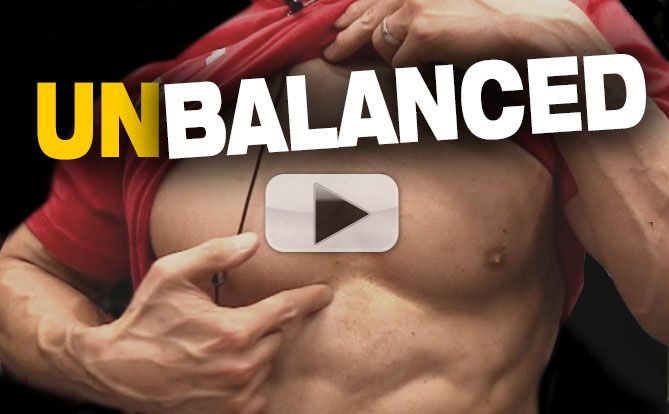
If you’re like most people who work out… You’ve got some muscle group that isn’t all that balanced.
One bicep bigger than the other. One delt that’s noticeably larger. OR MOST COMMONLY… One pec that is smaller, weaker or differently shaped than the other.
Can it be fixed? Maybe. See what I mean in this brand new “AX Jeff” video
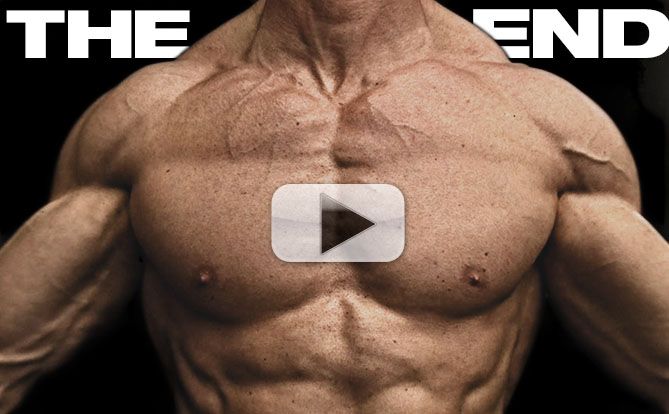
In the last few weeks… I showed you ways to finish off your triceps and delts with some super intense “finishers”!
Today… It’s time for the chest! Chest Workout “Finisher” – Pecs Punished! By putting the science back in strength… I’m going to show you a perfect way to push your pecs past their breaking point to all new growth!
The perfect way to end your chest workout!
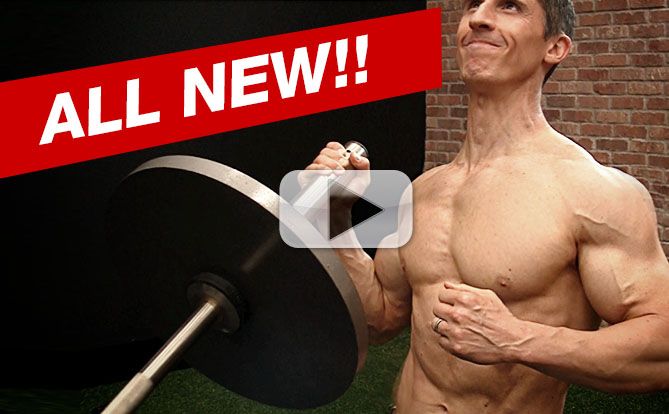
Is your chest workout feeling a little bit stale?
Bench press. Dips. Pushups. Repeat… Until now! 3 New Chest Exercises (You’ve Never Done!) These exercises were actually created out of necessity when training at home.
When I first started working out… I had a barbell (that came with the olympic weight set) but no bench! SO… These can all be done without a bench.
Build a bigger chest with these 3 new exercises Try these at home or in the gym!



